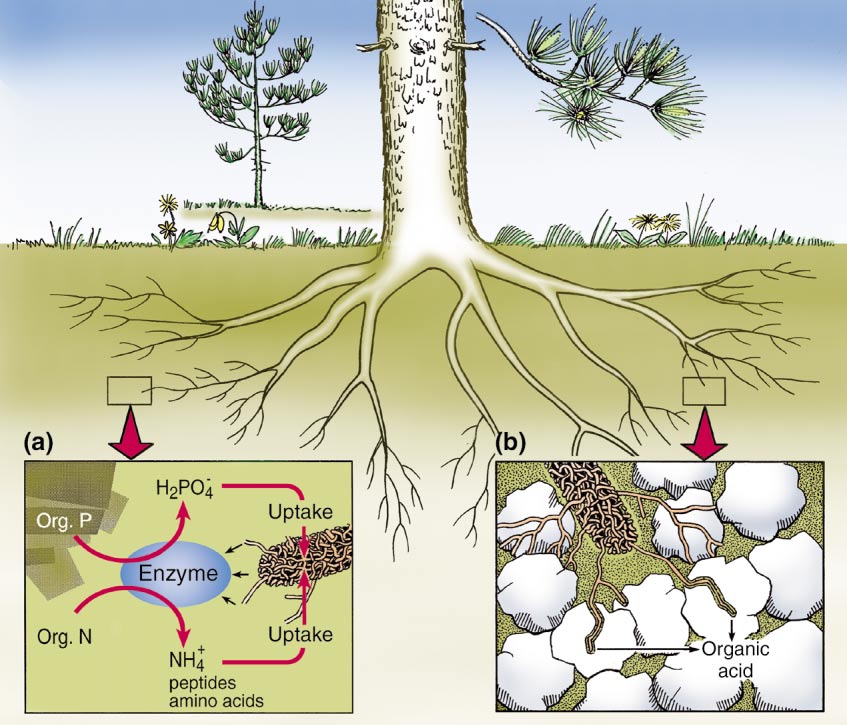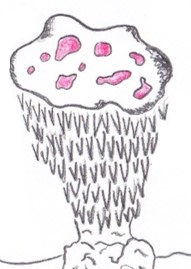
Interspecies Interactions
The most notable interaction H. peckii has with
other organisms is the ectomycorrhizae if forms with trees,
almost always conifers. Specfically, H. peckii is
known to form ectomycorrhizae with the genera Pinus (pines),
Picea (spruces), Tsuga (Hemlock), Peeudotsuga (Douglas Fir), and possibly
Betula (birches) (Newton et al.). Ectomycorrhizae
are symbiotic associations between fungi and plants in which the
roots of the host plant are enveloped in a 'sheath' of
fungal hyphae. As the plant root grows, the hyphae
encasing the root grow with it. Additionally, the hyphae from
the fungus excrete enzymes called pectinases which allow the
hyphae to nestle themselves in between the outer
cells of the plant root and form what is referred to as a Hartig net. The vast surface area of the Hartig net serves as
the primary junction of chemical exchange between H.peckii
and its symbiont (Moore et al., 2011). The figure above shows a
cross-section of an ectomycorrhiza. The sheath of hyphae
encapsulating the plant root has been labeled (a), a plant
root cell has been labeled (b), and (c) denotes the Hartig net.
The ectomycorrhizae H. peckii contributes to are
mutualistic—both fungus and plant benefit. H. peckii
shares water and nutrients such phosphorus, potassium, and
nitrogen with with plant, while the plant reciprocates by sharing
carbohydrates. The ectomycorrhizal relationship between
H.peckii and conifers has been so engrained by evolution that
neither species can survive without the other. H.peckii
is dependent upon carbohydrates from the conifer because it is
no longer versed in sapotrophy (decomposing) like most other fungi.
Likewise, the conifer relies on H.peckii, or other
ectomycorrhizal fungi, because these fungi secrete enzymes and acid
that give trees access to many organic
nutrients that would be otherwise unavailable to them. The inset
labeled (a) in the diagram to the right illustrates
enzyme-facilitated nutrient acquisition by the fungus in which the
fungus secretes an enzyme that liberates organic nutrients such as
phosphorus and nitrogen from the soil and absorbs them to share with
the plant. The inset labeled (b) shows how the fungi use acid to help
break down rocky substrates and access their nutrients. Not
only do ectomycorrhizal fungi contribute precious nutrients to their
relationships, they also provide extensive surface area with their
mycelia to augment the sheer nutrient uptake capacity (Landeweert et al. 2001).
between
H.peckii and conifers has been so engrained by evolution that
neither species can survive without the other. H.peckii
is dependent upon carbohydrates from the conifer because it is
no longer versed in sapotrophy (decomposing) like most other fungi.
Likewise, the conifer relies on H.peckii, or other
ectomycorrhizal fungi, because these fungi secrete enzymes and acid
that give trees access to many organic
nutrients that would be otherwise unavailable to them. The inset
labeled (a) in the diagram to the right illustrates
enzyme-facilitated nutrient acquisition by the fungus in which the
fungus secretes an enzyme that liberates organic nutrients such as
phosphorus and nitrogen from the soil and absorbs them to share with
the plant. The inset labeled (b) shows how the fungi use acid to help
break down rocky substrates and access their nutrients. Not
only do ectomycorrhizal fungi contribute precious nutrients to their
relationships, they also provide extensive surface area with their
mycelia to augment the sheer nutrient uptake capacity (Landeweert et al. 2001).
It is also notable that trees in association with ectomycorrhizal fungi have suppressed root hair development, which hinders their ability to absorb nutrients without aid (Moore et al., 2011). Such a relationship in which both parties need the other to survive is termed an obligate mutualism. The uniquely intimate relationship between H.peckii and its arboreal symbionts can be exploited by 'seeding' trees with H.peckii to aid reforestation efforts.
Ectomycorrhizae are more than just a relationship between a fungus and tree, they also connect trees with other trees by creating a 'wood-wide-web' (Moore et al. 2011). This expansive underground latticework of mycelia and roots enables intercellular communication between many organisms and facilitates their aggregate ability to adapt to changing environmental conditions.
Ectomycorrhizae aside, you may be wondering what other types of
interactions H. peckii has. The answer may be
dissatisfying. Due to its acrid, aversive taste (and despite its tantalizing
resemblance to a scrumptious French pastry) you won't encounter
many
sylvan critters munching on H. peckii. The closest thing to
predation H. peckii encounters is in its interactions with the
dreaded Ho mo sapiens. Although H.peckii is non-toxic, it is
too bitter for human palatability;however, humans sometimes pick
H.peckii to use in mushroom dying. Also, human contributions of
atmospheric nitrogen pollution may have an adverse affect on H.
peckii which is known to be especially sensitive to nitrogen
deposition in the soil (Van der Linde et al. 2009). In
summary: H. peckii is kind of an introvert, its best
friends are conifers, and humans are conceited bullies.
mo sapiens. Although H.peckii is non-toxic, it is
too bitter for human palatability;however, humans sometimes pick
H.peckii to use in mushroom dying. Also, human contributions of
atmospheric nitrogen pollution may have an adverse affect on H.
peckii which is known to be especially sensitive to nitrogen
deposition in the soil (Van der Linde et al. 2009). In
summary: H. peckii is kind of an introvert, its best
friends are conifers, and humans are conceited bullies.
Now, hang on to your hyphae—it's time for a spooky story.
